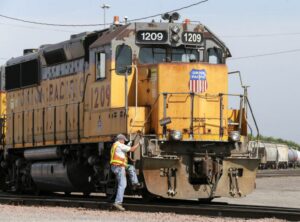Behind the scene
Our climate correspondents

After almost three years of stymied contract negotiations, rail workers voted 99% this summer in favor of a strike. That threat was averted when the Biden administration stepped in. By September there was a tentative proposal agreed to by the companies and submitted to the unions. But it’s not over.
It’s more than a labor dispute
In their implacable pursuit of higher profits, corporate owners of the nation’s railroads have consolidated systems, gutted capacity and fired a third of the workforce. Carriers like BNSF made up for the resulting lack of employees by running longer trains and imposing new conditions on remaining workers: no sick leave, 12-hour work days, mandatory on-call weeks, and penalties (up to termination) for those who take time off. Their plan: a train run by electronics with a lone crew member in the cab.
The result?
For the companies: a 50.9% profit margin—the highest of all US industries, according to the Surface Transportation Board, in the last decade railroad owners spent $50 billion more on buybacks and dividends than on infrastructure.
For the shippers: fewer trains, crippling rates, delays and poor service.
For the workers: loss of an 8-hour day, predictable schedules, the ability to take time off for health, family and personal life, the right to safety on the job.
For the community: Degradation of commuter and passenger rail service; loss of jobs that offer a living wage for a day’s work under healthy conditions; less participation in family and civic life.
Does the Biden-brokered agreement solve the problem?
The threat of a strike remains. The proposed agreement barely addressed the punitive attendance policies, specifying simply time away from work to attend to routine and preventive medical care, and allowing exemptions from attendance policies for hospitalizations and surgical procedures. The deal preserved two-person crews for a period, and offered a significant raise over four years.
Several unions voted no on the Tentative Agreement, insisting “It offers very little given the conditions we face and the role we play in the economy.” If railroad workers strike, it will have immediate implications—economically and politically—for people and businesses everywhere.
From their beginning, railroads—like highways and airports—have been considered “common carriers” providing an essential public service. Too important for the whole community to be left to the dictates of profit. Railroads were the first industry to be regulated in the public interest in 1879. That changed in 1980 when the Staggers Rail Act ended most regulation.
Rail shipments and travel in today’s world should be expanding, not contracting
Trucks today account for over 70% of intercity freight, with semi’s getting an average of 6.5 miles per gallon. At a time when the demand is to reduce fossil fuel consumption and decrease pollutants, semi trucks account for 25% of all transportation emissions, adding environmental damage to the damage they inflict on roads and highways.
Shipping by rail is cheaper and produces fewer emissions. One gallon of diesel fuel moves a ton of freight 500 miles. Compared to trucks, freight rail accounts for 0.5% of all greenhouse gases. But despite these efficiencies and environmental benefits, railroads companies have reduced their share of the market, moving less freight today than 16 years ago.
A call for public ownership
The dictates of profit have again overtaken the public interest, and Railroad Workers United, a cross-craft railroad workers’ group is calling for public ownership of the rail system. RWU gives the reasons for this position in a Resolution of Support for Public Ownership of the Railroads. They call on other groups—including rail unions, the larger labor movement, environmental and social justice groups, communities and shippers to join the campaign.”
RWU believes that reliance on highways, cars and trucks threatens to bankrupt and destroy towns and cities across the country and contribute to ecological disaster. Expanding rail travel is a way forward, but the privately held rail system has proven itself uninterested and incapable of rising to the challenge.
“Railroad workers are in a position to take the lead,” according to RWU Steering Committee member and passenger conductor J.P. Johnson. “We can spearhead the drive for a rail renaissance in this country, one that is vibrant and expanding, innovative, creative and environmentally sustainable, one that can properly handle the nation’s freight and passengers in the 21st century.”
This article was a collaborative effort using data from the Surface Transportation Board, American Journal of Transportation and the RWU newsletter, among other sources. Rail workers and others who would like more information are invited to contact RWU.
Be First to Comment